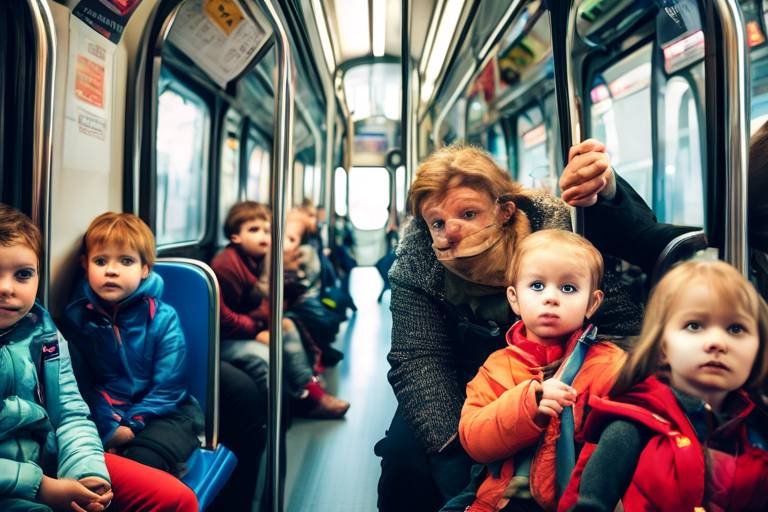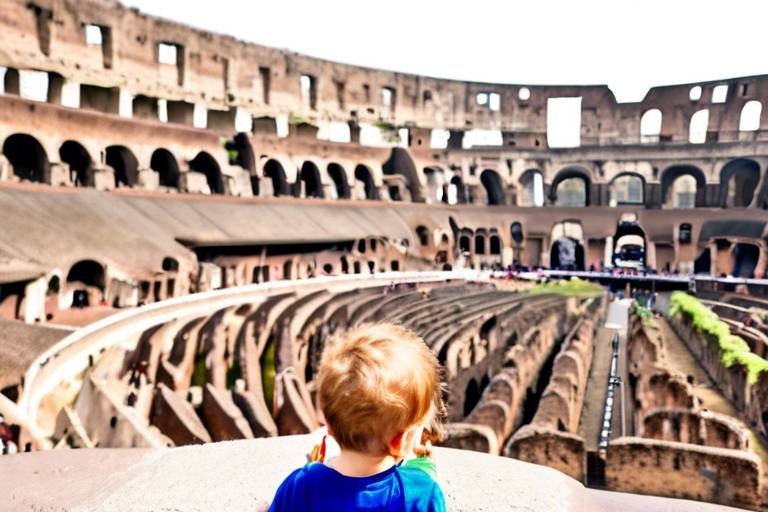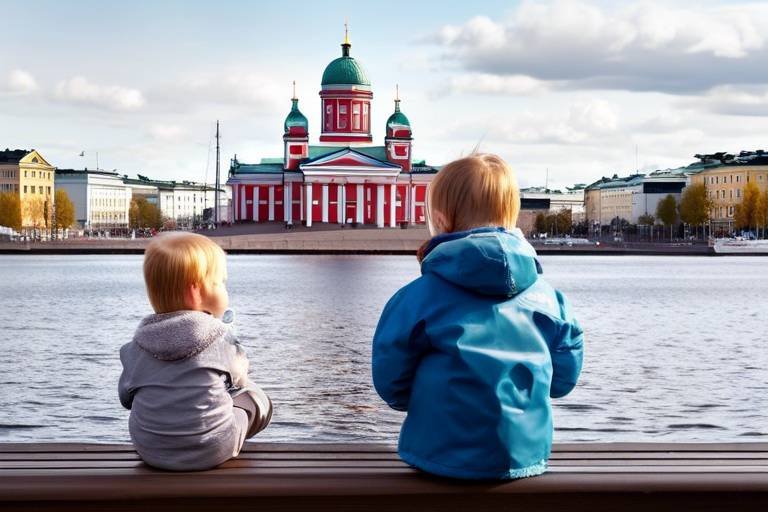Navigating Public Transport with Kids in Europe
Traveling through Europe with kids can be an exhilarating adventure, but the thought of navigating public transport might feel overwhelming. Fear not! With a little planning and some insider tips, you can turn potential travel chaos into a smooth and enjoyable experience. Imagine hopping on a train in Paris, riding a tram in Prague, or taking a bus in Barcelona—all while keeping your little ones entertained and happy. This article provides essential tips and insights for families traveling through Europe using public transport, ensuring a smooth and enjoyable experience for both parents and children.
Europe is a treasure trove of public transport options, and choosing the right one can make all the difference. From trains that whisk you across countries in a flash to buses that offer scenic routes through quaint towns, the choices are plentiful. Each city has its own unique system, so it’s vital to understand what’s available. For instance, in cities like Amsterdam, trams are a fantastic way to get around, while in London, the iconic double-decker buses are a must-try. When selecting the best transport for your family, consider the following:
- Distance: How far do you need to travel?
- Cost: What’s your budget for transport?
- Convenience: How accessible is the transport with kids and strollers?
By weighing these factors, you can make an informed decision that suits your family’s needs.
Once you’ve chosen your mode of transport, it’s time to plan your journey. This step is crucial, especially when traveling with children who may not have the patience for unexpected delays or detours. Start by mapping out your route using online tools or apps that provide real-time information. Familiarize yourself with timetables and any connecting services you might need. This preparation can help minimize travel stress and ensure a smooth ride. Remember, it’s always a good idea to arrive at the station a little early. This gives you time to find your platform, grab a snack, and let the kids stretch their legs before boarding.
Ticketing systems across Europe can be as diverse as the cultures they represent. Understanding how they work can save you both time and money. Most cities offer single tickets, day passes, and even family discounts. For example, in cities like Berlin, families can benefit from discounted group tickets that cover multiple trips throughout the day. To navigate these systems effectively, consider:
- Researching local ticket options before your trip.
- Asking locals or transport staff for advice on the best ticket for your needs.
- Utilizing apps that allow you to purchase tickets directly from your smartphone.
By familiarizing yourself with the ticketing options, you can make informed choices that enhance your travel experience.
In today’s digital age, buying tickets online has become a game-changer for travelers. Imagine skipping the long queues at the station and heading straight to your platform! Purchasing tickets in advance not only saves time but may also offer potential discounts. Many transport services provide online platforms where you can buy tickets for trains, buses, and trams. Just a few clicks, and you’re all set! Plus, having your tickets ready means you can focus on more important things, like keeping your kids entertained during the journey.
When traveling with children, it’s essential to teach them about onboard etiquette and safety. Public transport is a shared space, and being respectful towards fellow passengers goes a long way. Remind your kids to use their indoor voices, not to block the aisles with their bags, and to give up their seats for those in need. Safety is paramount, so always keep an eye on your little ones, especially in crowded areas. Holding hands or using harnesses for younger children can help keep them secure while navigating busy stations.
Managing strollers and luggage on public transport can feel like a juggling act, but with some tips, you can make it easier. Most European cities are becoming increasingly accessible, with many trains and buses accommodating strollers. However, it’s wise to check the specific accessibility options of your chosen transport. When boarding, look for designated areas for strollers and luggage. If your child is old enough, encourage them to help carry small bags. This not only lightens your load but also gives them a sense of responsibility.
Keeping kids entertained during long journeys is crucial for a pleasant experience. Think of public transport as a mini adventure! Bring along a few travel games, coloring books, or even download some family-friendly movies on your tablet. Engaging them with questions about the sights you’re passing can also spark their curiosity. “What do you think that building is?” or “How many different languages do you think we’ll hear today?” can keep their minds active and engaged.
Let’s face it—hungry kids can turn a pleasant journey into a nightmare! Packing convenient snacks and meals can keep spirits high. Think about easy-to-eat options like fruits, nuts, or sandwiches. If you’re traveling on a longer journey, consider stopping at local markets or bakeries to grab fresh treats. Not only does this provide nourishment, but it also gives you a chance to experience local cuisine. Remember to pack a refillable water bottle to keep everyone hydrated!
Layovers can be a drag, but they don’t have to be! Instead of waiting idly, turn that time into an opportunity for fun. Research nearby attractions or parks where your family can stretch their legs and explore. Many airports and train stations also have play areas designed for kids, which can be a lifesaver during long waits. By making the most of layovers, you can create memorable experiences rather than just passing the time.
Q: Is public transport safe for kids in Europe?
A: Yes, public transport in Europe is generally safe. However, it’s always wise to keep a close eye on your children and teach them basic safety rules.
Q: Can I bring a stroller on public transport?
A: Most public transport systems in Europe are stroller-friendly, but it’s best to check specific regulations for the city you’re visiting.
Q: What snacks are best for traveling with kids?
A: Opt for non-perishable snacks like granola bars, dried fruits, and nuts. Fresh fruits and sandwiches are great for shorter trips.
Q: How can I keep my kids entertained during long journeys?
A: Bring along games, books, or download movies and shows on a tablet. Engaging them with questions about your surroundings can also keep them entertained.

Choosing the Right Transport Options
When it comes to exploring the vibrant cities of Europe with your little ones in tow, choosing the right transport option can make all the difference. Europe boasts a variety of public transport systems, including trains, buses, and trams, each offering unique advantages. But how do you decide which one is best for your family? Think of it like picking the right tool for a job; each mode of transport has its strengths and weaknesses, and understanding these can help you create a smoother travel experience.
For instance, if you're planning to traverse long distances between cities, trains are often the fastest and most comfortable option. High-speed trains like the Eurostar or Thalys can whisk you from one city to another in a matter of hours, allowing you to sit back, relax, and enjoy the scenic views. Plus, many train stations are conveniently located near city centers, making it easier to explore.
On the other hand, if you’re navigating a single city, buses and trams can be incredibly convenient. They often run frequently and cover areas that may not be accessible by train. For families, this can be a less stressful option since you won’t have to worry about catching a specific train. Just hop on the next bus or tram and enjoy the ride! However, keep in mind that city traffic can sometimes lead to delays, so plan accordingly.
Another important factor to consider is accessibility. Some public transport options are more family-friendly than others. For example, many European cities have made significant strides in making their transport systems accessible for strollers and wheelchairs. Always check the transport provider's website for information on accessibility features. It’s essential to ensure that you can easily board and disembark, especially with toddlers or young children in tow.
Additionally, consider the length of your journey. If you’re traveling for several hours, you might want to opt for trains that offer amenities like onboard dining, spacious seating, and even play areas for kids. On the flip side, if your journey is short, a quick bus ride might suffice. The key is to balance comfort with practicality based on your specific travel needs.
To help you visualize your options, here's a simple comparison table:
| Transport Type | Best For | Pros | Cons |
|---|---|---|---|
| Train | Long distances between cities | Fast, comfortable, scenic views | Can be more expensive |
| Bus | City travel | Frequent stops, economical | Subject to traffic delays |
| Tram | City travel | Convenient for short distances | Limited routes |
In conclusion, the right transport option for your family will depend on various factors such as distance, convenience, and comfort. By weighing these considerations, you can make informed decisions that cater to your family’s needs. Whether you choose the speed of trains or the flexibility of buses and trams, the key is to enjoy the journey as much as the destination!

Planning Your Journey
When it comes to traveling with kids in Europe, is crucial for a stress-free experience. Imagine navigating bustling train stations or crowded bus stops without a clear plan—it can feel like trying to find a needle in a haystack! To avoid the chaos, take a moment to map out your route. Start by identifying your destination and the most suitable public transport options available. Most European cities have extensive public transport networks, and knowing what’s available can make all the difference.
Utilize online tools and apps to check timetables and plan your connections. Websites like Google Maps or local transport apps provide real-time information, helping you stay updated on delays or changes. If you’re traveling during peak hours, try to plan your journey outside of rush hour to ensure a more comfortable experience. Trust me, no one wants to be squished between a backpack and a toddler during a packed train ride!
Another vital aspect of planning is understanding the layout of the transport system. Familiarize yourself with the stations and stops you’ll be using. Many cities provide maps at the stations, but having a digital copy on your phone can save you time. Consider creating a simple itinerary that includes:
- Your starting point and destination
- Transport options and their schedules
- Estimated travel times
- Any transfers or connections
For families, it’s also wise to plan for unexpected delays. Kids can get restless, so having a backup plan or alternative activities can be a lifesaver. For instance, if your train is delayed, knowing where nearby parks or cafes are can help you keep the little ones entertained until it’s time to board.
Lastly, don’t forget about the importance of snack breaks. Pack some easy-to-eat snacks to keep energy levels up during your travels. A hungry child can quickly turn a pleasant journey into a challenging one. With a bit of foresight and planning, you can transform your public transport experience into a delightful adventure for the whole family!
Q: How far in advance should I plan my journey?
A: It’s best to plan your journey a few days in advance, especially if you’re using multiple forms of transport or traveling during busy seasons. This allows you to familiarize yourself with routes and schedules.
Q: Are there family discounts available for public transport?
A: Yes, many cities offer family discounts or special passes for children. Always check the transport company’s website for details on available deals.
Q: What should I do if my child gets restless during the journey?
A: Bring along some small toys, books, or electronic devices loaded with games or movies to keep them entertained. Engaging them in conversation or playing games can also help pass the time.
Q: Is it necessary to buy tickets in advance?
A: While it’s not always necessary, purchasing tickets in advance can save you time and sometimes money, especially for longer journeys or popular routes.

Understanding Ticketing Systems
When traveling through Europe with your family, understanding the ticketing systems can feel like navigating a maze. Each country and even cities within the same country often have their own unique systems, which can be overwhelming. However, getting a grip on how these systems work is crucial for a smooth journey. You’ll want to consider several factors, such as the types of tickets available, the costs, and any potential discounts that can save you money.
First off, let’s break down the types of tickets you’ll commonly encounter. Most public transport systems offer single tickets for one-off journeys, which are perfect if you’re hopping on and off. Then, there are day passes, which allow unlimited travel within a certain time frame—ideal for families planning to explore a city in depth. Additionally, many cities offer family discounts, which can be a real lifesaver for larger families. These discounts can vary widely, so it’s always worth checking the local transport website or app.
Another aspect to consider is the validity period of tickets. For instance, in some places, a ticket might be valid for a specific duration after first use, allowing you to make multiple trips without needing to purchase a new ticket each time. This can be particularly beneficial when you have little ones in tow, as it gives you the flexibility to explore without the pressure of buying new tickets constantly. Make sure to familiarize yourself with these rules, as they can differ significantly from one region to another.
| Ticket Type | Description | Ideal For |
|---|---|---|
| Single Ticket | For one journey on public transport | Quick trips |
| Day Pass | Unlimited travel for a day | Exploring a city |
| Family Discount | Reduced fare for families | Families traveling together |
Now, let’s talk about buying tickets. Many cities have made it easier than ever to purchase tickets online or via mobile apps. This can save you time and the hassle of waiting in long lines, especially during peak tourist seasons. Plus, some transport systems offer exclusive online discounts, so you might even save a few bucks. Imagine standing in line with a restless child; the convenience of buying tickets from your phone can turn a potential headache into a breeze!
Lastly, don’t forget to check if the transport system offers combination tickets that include entry to popular attractions. This can be a fantastic way to maximize your budget and make the most out of your trip. By bundling transportation and attractions, you can streamline your experience and keep your kids engaged without the stress of multiple ticket purchases.
In summary, understanding the ticketing systems in Europe is essential for making your family travel experience enjoyable and stress-free. By familiarizing yourself with the different ticket types, purchasing options, and potential discounts, you can navigate public transport like a pro. Just remember to plan ahead and keep an eye out for the best deals to ensure a smooth journey with your little ones!

Buying Tickets Online
When it comes to traveling in Europe with kids, one of the best decisions you can make is buying your public transport tickets online. Imagine this: you're at a bustling train station, surrounded by a sea of travelers, and your little ones are getting restless. The last thing you want is to stand in a long queue, waiting to buy tickets while your kids are itching to explore. By purchasing tickets online, you can skip that hassle altogether and focus on what really matters—creating memories with your family.
Many European transport services offer user-friendly websites and mobile apps that allow you to purchase tickets in advance. This not only saves you valuable time but can also lead to significant savings. Some providers offer discounts for early bird purchases or family packs, which can be a game-changer for your travel budget. Plus, you can easily compare prices and options from the comfort of your home, ensuring you get the best deal available.
Another perk of buying tickets online is the convenience of having your tickets stored digitally. Most apps allow you to keep your tickets on your smartphone, eliminating the need for paper tickets that can easily get lost or damaged. Just imagine the peace of mind knowing you have everything you need right at your fingertips. When you arrive at the station, you can simply show your digital ticket on your phone to the conductor or ticket collector, making the boarding process a breeze.
However, it's important to keep a few things in mind when buying tickets online:
- Check the cancellation policy: Plans can change, especially when traveling with kids. Make sure you understand the terms regarding refunds or changes to your tickets.
- Be aware of time zones: If you're booking tickets while in a different country, double-check the departure times. Nothing is worse than missing a train because of a time zone mix-up!
- Download the app: If the transport provider has a mobile app, download it! This can make accessing your tickets and any updates about your journey much easier.
In conclusion, buying tickets online is not just a smart choice; it's a stress-relieving strategy that can enhance your travel experience in Europe. By planning ahead and securing your tickets before you even step foot in the station, you can enjoy a smoother journey and keep your kids engaged and excited about the adventure ahead. So, before you pack your bags, make sure to check out the online ticketing options for your chosen transport. Your future self—and your kids—will thank you!
1. Can I buy tickets online for all types of public transport in Europe?
Yes, most major public transport systems, including trains, buses, and trams, offer online ticket purchasing options. However, it's best to check the specific transport provider's website or app for availability.
2. Are there any fees associated with buying tickets online?
Some providers may charge a small fee for online purchases, while others may offer discounts. Always compare prices and read the terms before purchasing.
3. What if my plans change and I need to cancel my tickets?
Cancellation policies vary by provider. Make sure to read the terms and conditions when purchasing your tickets online to understand your options.
4. Can I use my smartphone to show my ticket?
Absolutely! Most transport services accept digital tickets displayed on your smartphone. Just ensure your phone is charged and you have internet access if needed.

Onboard Etiquette and Safety
Traveling with kids on public transport can be a delightful adventure, but it also comes with its own set of challenges. Understanding onboard etiquette and safety measures is essential for ensuring a smooth journey for your family and fellow passengers. First and foremost, it's crucial to teach your children the importance of keeping noise levels down. While excitement is part of the travel experience, loud conversations or playing music without headphones can disturb others. Consider this: if you wouldn’t want to hear someone else's music blaring in your ear, your fellow passengers likely feel the same way!
Another aspect of etiquette involves giving up seats for those who might need them more, such as elderly passengers or pregnant women. Instilling this value in your kids not only promotes kindness but also helps them understand the importance of community and respect. If your child is sitting in a designated priority seat, gently remind them to stand up if someone requires it. This small act can make a big difference in someone else's day.
When it comes to safety, always ensure that your children are seated properly, especially on buses and trams that may take sharp turns. If your little ones are in strollers, make sure they are securely locked and not blocking aisles or exits. It's also wise to keep an eye on your belongings. Use a bag with zippers and hold it close to you, as crowded spaces can attract pickpockets. Teach your children not to leave their bags unattended, as this can lead to lost items or worse, theft.
Additionally, familiarize your kids with the emergency procedures for the specific mode of transport you are using. For instance, if traveling by train, point out the emergency exits and explain what to do in case of an emergency. This knowledge can empower them and help reduce anxiety during unexpected situations. Remember, staying calm and collected as a parent sets the tone for your children. If they see you relaxed and confident, they'll likely mirror that behavior.
Lastly, don't underestimate the importance of communication. Discuss the rules of public transport with your children before your journey. Use this opportunity to engage them in a conversation about why these rules exist. By making them part of the discussion, they are more likely to remember and adhere to these guidelines. In essence, teaching your kids about onboard etiquette and safety isn’t just about following rules; it’s about fostering a sense of responsibility and respect for others.
- What should I do if my child is being disruptive on public transport?
If your child is being disruptive, gently remind them of the importance of being respectful to others. Engaging them with a game or a quiet activity can help redirect their energy. - Are there any specific safety measures for strollers on public transport?
Yes, always make sure your stroller is securely locked when in use, and try to keep it out of the aisles to avoid tripping hazards. - How can I teach my kids about giving up seats?
Role-play scenarios at home where they practice offering their seat to someone in need. This can make them more comfortable with the idea when the situation arises.

Traveling with Strollers and Luggage
Traveling with kids can feel like a juggling act, especially when you throw strollers and luggage into the mix. But fear not! With a little planning and the right mindset, you can navigate public transport in Europe without losing your marbles. First things first, let’s talk about strollers. Many European cities are quite stroller-friendly, but some older transport systems might pose challenges with stairs and narrow aisles. It's a good idea to check the accessibility of your chosen transport before you hop on. Some cities even offer special services for families with young children, so keep an eye out for those!
Now, onto luggage. Traveling light is key, but we all know that kids come with their fair share of stuff—diapers, snacks, toys, and more. Here’s a pro tip: consider using backpacks instead of bulky suitcases. They’re easier to carry and allow for better mobility when navigating crowded platforms or buses. If you must bring a stroller, opt for a lightweight, foldable model that can be easily stashed in overhead compartments or under your seat. Trust me, your back will thank you later!
When it comes to managing your belongings, organization is your best friend. Use packing cubes or compression bags to keep everything in its place. This way, when you need to grab a snack or a toy, you won’t have to dig through a bottomless pit of chaos. If you’re traveling by train, many stations have luggage storage facilities, which can be a lifesaver if you want to explore the city without dragging your bags along.
Lastly, always be aware of your surroundings and the safety of your children. Keep an eye on your belongings and make sure your little ones are close by, especially in busy stations or during transfers. It’s easy to get swept up in the excitement of travel, but a little vigilance goes a long way in ensuring everyone has a safe and enjoyable journey.
- Is it easy to find stroller-friendly public transport in Europe? - Yes, many European cities are increasingly accommodating to families with strollers, but it's wise to check specific transport options ahead of time.
- What type of luggage is best to travel with kids? - Lightweight backpacks or rolling suitcases are ideal as they are easier to manage on public transport.
- Are there facilities for storing luggage at train stations? - Most major train stations offer luggage storage services, allowing you to explore without the burden of your bags.

Engaging Kids During Travel
Traveling with kids can sometimes feel like herding cats, right? They have boundless energy and an insatiable curiosity, which can be both a blessing and a challenge, especially when you're navigating the maze of public transport in Europe. So, how do you keep their spirits up and their minds engaged during those long journeys? Here are some creative strategies that can transform your travel time into fun time!
First off, consider the power of games. A simple game of "I Spy" can turn the mundane scenery outside the window into an exciting adventure. Encourage your kids to spot landmarks, animals, or even the color of different vehicles. If you have older children, you might want to introduce them to classic travel games like the "License Plate Game" or "20 Questions." Not only do these games keep them occupied, but they also stimulate their observational skills and imagination.
Another fantastic way to keep your little ones engaged is through storytelling. You can either read them a book or create a story together. Imagine weaving a tale about a brave knight on a quest to find the best pizza in Italy or a young explorer discovering hidden treasures in the parks of Paris. This not only entertains them but also sparks their creativity and keeps their minds active. Plus, it can be a wonderful bonding experience for the whole family!
For tech-savvy families, using technology wisely can also be a game-changer. Tablets or smartphones loaded with educational apps, audiobooks, or family-friendly movies can be lifesavers on long journeys. Just remember to bring headphones to avoid disturbing fellow passengers. You can even download some offline content beforehand, so you’re not scrambling for Wi-Fi. However, moderation is key; balance screen time with other engaging activities to keep their attention spans intact.
Speaking of balance, don’t forget about the importance of snacks. Keeping your kids well-fed can prevent meltdowns and crankiness. Pack a variety of healthy snacks such as fruit slices, nuts, and granola bars, alongside a few treats to keep things exciting. You can even turn snack time into a mini adventure by asking them to guess the flavors or textures of what they’re eating. This not only keeps them nourished but also makes them feel involved in the journey.
Finally, involve your kids in the travel planning process. Allow them to choose some activities or sights they want to see at your destination. This gives them a sense of ownership over the trip and makes them more excited about the journey itself. You could even create a travel journal where they can document their experiences, drawing pictures or writing about their adventures. This not only engages them during the trip but also gives them something tangible to remember it by.
In summary, keeping kids engaged during travel is all about creativity and interaction. Whether through games, storytelling, technology, snacks, or involving them in the planning, these strategies will not only make your journeys smoother but also create lasting memories for your family. So, next time you’re on a train or bus in Europe, try out these tips and watch your kids’ excitement soar!
| Question | Answer |
|---|---|
| What are some good travel games for kids? | Games like "I Spy," "20 Questions," and the "License Plate Game" are great for keeping kids entertained during travel. |
| How can I keep my kids engaged without screens? | Storytelling, packing snacks, and involving them in planning can keep them engaged without relying on screens. |
| What snacks are best for traveling with kids? | Healthy options like fruit slices, nuts, and granola bars, along with a few treats, work well to keep kids nourished and happy. |

Snacks and Meals on the Go
When traveling through Europe with kids, one of the biggest challenges can be keeping those little tummies satisfied while navigating the bustling public transport systems. Imagine this: you're on a crowded train, the scenery is whizzing by, and suddenly you hear the dreaded phrase, "I'm hungry!" Panic sets in, but fear not! With a little planning, you can ensure that your family stays nourished and happy throughout your journey.
First things first, snacks are your best friend. They are easy to pack, require no preparation, and can be a lifesaver when hunger strikes. Think about packing a variety of snacks that cater to different tastes and preferences. Some popular options include:
- Fruits: Apples, bananas, and grapes are portable and mess-free.
- Nuts and Seeds: A great source of protein, but be cautious if you have nut allergies in the group.
- Granola Bars: These are filling and come in a variety of flavors, making them a hit with kids.
- Cheese Sticks: A fun and tasty way to get some calcium on the go.
- Crackers: Pair them with some cheese or hummus for a satisfying snack.
Now, while snacks are great, there will be times when you need something a bit more substantial. In these cases, consider packing easy-to-eat meals or exploring local food options. If you prefer to bring your own meals, sandwiches are always a winner. Opt for fillings that won’t spoil quickly, such as turkey, cheese, or veggies. Wrap them tightly to prevent any mess, and you’ll have a delicious meal ready to go!
However, don't shy away from trying local cuisine during your travels. Many European cities have fantastic street food options that are both affordable and kid-friendly. Think about stopping at a local market or food stall where you can find:
- Crepes: These delicious thin pancakes can be filled with sweet or savory ingredients.
- Pizza by the slice: Easy to eat on the go and a favorite among kids.
- Pastries: From flaky croissants to sweet treats, these are perfect for a quick snack.
When it comes to drinks, stay hydrated! Carry a refillable water bottle for each family member. Many European cities have water fountains where you can refill your bottles, making it easy to keep everyone refreshed without spending a fortune on bottled water.
Lastly, remember that meal times can also be an opportunity to engage with your children. Encourage them to try new foods and share their thoughts on what they like or dislike. This can turn a simple meal into a fun family activity, creating memories that will last long after the trip is over. So, whether you’re munching on snacks in a train compartment or enjoying a meal at a bustling street market, the key is to keep it simple, fun, and delicious!
1. What are some kid-friendly snack options for traveling?
Some great options include fruits, granola bars, cheese sticks, and crackers. These snacks are easy to pack and mess-free!
2. Can we find healthy meal options while traveling?
Absolutely! Many European cities offer fresh and healthy street food options like wraps, salads, and grilled meats.
3. How can we keep drinks cool during travel?
Using insulated water bottles can help keep drinks cool. Additionally, many public transport stations have water fountains for refills.

Making the Most of Layovers
Layovers can often feel like a necessary evil when traveling with kids, but what if I told you they could be transformed into a mini-adventure? Instead of viewing layover time as a dull waiting period, think of it as an opportunity to explore new places, even if it's just for a couple of hours. Imagine stepping off a train or bus and into a new city, even if just for a brief moment. The key is to plan ahead and make the most of that time!
First things first, always check the duration of your layover. If you have a longer layover—say, over three hours—you might have enough time to venture out and explore. However, if it's shorter, you might want to stick around the station or terminal. Many European cities are well-connected to their transport hubs, making it easy to hop on a tram or bus and head into town. Just remember to account for travel time back to your departure point!
When planning your layover adventure, consider these tips:
- Research Nearby Attractions: Before your trip, look up what’s close to your layover station. Many cities have tourist information centers right at the station, which can provide you with maps and recommendations.
- Pack Light: If possible, leave your heavy luggage at a storage facility in the station. Traveling with just a backpack makes everything easier and more enjoyable.
- Engage the Kids: Turn the layover into a fun scavenger hunt. Create a simple list of things for them to spot in the city, like a statue, a specific type of food, or a local landmark.
Moreover, if you're stuck in the terminal, don’t fret! Many airports and train stations have play areas or family-friendly facilities. You can also find cozy cafés where you can grab a snack and let the kids unwind. Some places even have kid-friendly entertainment options like small play areas or interactive displays.
Finally, if you find yourself with some downtime, consider this: could you use the time to teach your kids about the local culture? Look up a few fun facts about the city you're in, or even try a few phrases in the local language. It’s a great way to make the journey educational and engaging, turning what could be a monotonous wait into a rich learning experience.
1. How long should my layover be to explore the city?
A layover of at least three hours is generally a good rule of thumb to ensure you have enough time to travel into the city and back without feeling rushed.
2. What should I do if my layover is too short to leave the airport or station?
If your layover is short, look for amenities within the airport or station. Many have play areas, family lounges, or even small shops and restaurants where you can relax.
3. Is it safe to explore a city during a layover?
Yes, as long as you stay aware of your surroundings and keep an eye on the time. Stick to well-populated areas and follow local advice about safety.
4. Can I store my luggage during a layover?
Most major airports and train stations offer luggage storage services. This allows you to explore hands-free!
In conclusion, layovers don’t have to be a drag. With a little planning and creativity, you can make them a highlight of your journey through Europe. So next time you find yourself waiting, remember: adventure is just around the corner!
Frequently Asked Questions
- What are the best public transport options for families in Europe?
When traveling with kids, trains are often the most comfortable and spacious option. However, buses and trams can be great for shorter distances. Consider your family's needs, such as stroller accessibility and travel times, to choose the best option.
- How can I effectively plan our public transport journey?
Planning is key! Use apps or websites to map out your route, check timetables, and see if you need to make any connections. This way, you can minimize stress and keep your kids entertained during the journey.
- What should I know about ticketing systems in Europe?
Each country has its own ticketing system. Familiarize yourself with single tickets, day passes, and family discounts. This knowledge can save you both time and money, making your travels smoother.
- Is it better to buy tickets online or at the station?
Buying tickets online can save you a lot of hassle! You can avoid long queues at the station and sometimes even snag discounts. Plus, having your tickets in advance means one less thing to worry about when you arrive.
- What are some safety tips for traveling on public transport with kids?
Always keep an eye on your children and teach them about personal space. Make sure they know to hold onto a handrail if standing and to stay close to you. It's also a good idea to choose seats near the exit for quick access if needed.
- How can I manage strollers and luggage on public transport?
Many European cities offer accessible transport options, but it’s wise to check in advance. When boarding, look for designated areas for strollers and luggage. Travel light when possible, and consider using a backpack for easier mobility.
- What activities can I do to keep my kids entertained during travel?
Pack travel-friendly games, books, or download some fun apps on your tablet. Engaging them with stories or quizzes about the places you’re visiting can also make the journey more enjoyable!
- What snacks are best for traveling with kids?
Opt for easy-to-carry snacks like granola bars, fruit, or crackers. Avoid messy foods that could create a hassle during your travels. Keeping your kids nourished will help keep their spirits high!
- How can we make the most of layovers?
Layovers can be a great opportunity to explore! Research nearby attractions or parks where your family can stretch their legs. Even a quick snack break can turn downtime into a fun adventure!



















